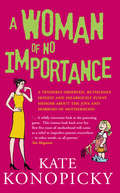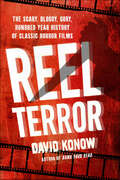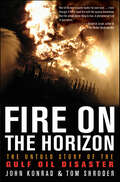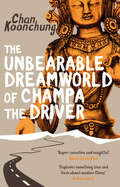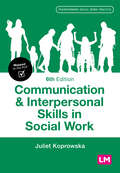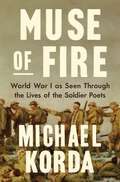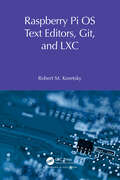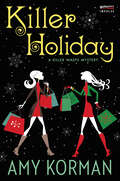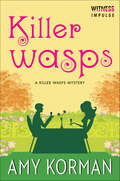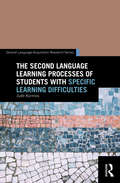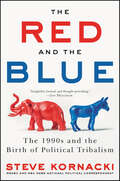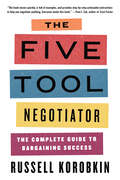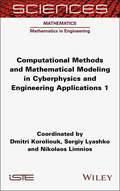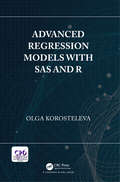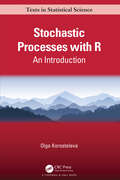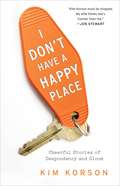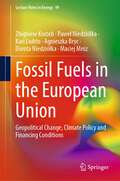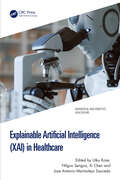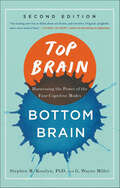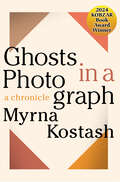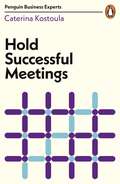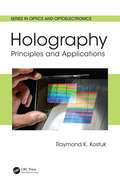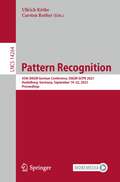- Table View
- List View
A Woman Of No Importance: A tenderly observed, ruthlessly honest and hilariously funny memoir about the joys and horrors of motherhood
by Kate KonopickyIf there's one thing that everyone has an opinion about it's how to bring up a child - especially your child. Kate Konopicky found herself an embattled mother, knowing that however hard she worked everything was wrong. If she went back to full-time employment she was neglecting her child. If she stayed at home the child would be clingy and shy. So, she became a combination of teacher, nurse, nutritionist, psychologist, entertainer and mind reader. She didn't get weekends off and never phoned in sick when she wanted a lie-in. The boss was illogical, demanding, incapable of undertaking the simplest task. Yes, we've all had jobs like that but at least we got paid for them. Kate Konopicky is an anarchic voice in the face of regimented parenting books. With brilliant humour, she'll make you believe you're not a failure when your fairy cakes don't rise, and you'll slowly come to realise that you may not be perfect but that you are doing your best.'A wildly irreverent look at the parenting game. This riotous look back over her first five years of motherhood will come as a relief to imperfect parents everywhere - in other words, to all parents.' You Magazine
Reel Terror: The Scary, Bloody, Gory, Hundred Year History of Classic Horror Films
by David KonowFrom the author of the definitive heavy metal history, Bang Your Head, a behind-the-scenes look a century of horror filmsReel Terror is a love letter to the wildly popular yet still misunderstood genre that churns out blockbusters and cult classics year after year. From The Cabinet of Dr. Caligari to Paranormal Activity, Konow explores its all-time highs and lows, why the genre has been overlooked, and how horror films just might help us overcome fear. His on-set stories and insights delve into each movie and its effect on American culture.For novices to all out film buffs, this is the perfection companion to this Halloween's movie marathons.
Fire on the Horizon: The Untold Story of the Gulf Oil Disaster
by John Konrad Tom Shroder"A phenomenal feat of journalism. . . . I tore through it like a novel but with the queasy knowledge that the whole damn thing is true." —Sebastian Junger, author of The Perfect Storm and WarBlending exclusive first-person interviews and penetrating investigative reporting, oil rig captain John Konrad and veteran Washington Post writer Tom Shroder give the definitive, white-knuckled account of the Deepwater Horizon explosion—as well as a riveting insider’s view of the byzantine culture of offshore drilling that made the disaster inevitable. As the world continues to cope with the oil spill’s grim aftermath—with environmental and economic consequences all the more dire in a region still rebuilding from Hurricane Katrina—Konrad and Schroder’s real-time account of the disaster shows us just where things went wrong, and points the way to a safer future for us all.
The Unbearable Dreamworld of Champa the Driver
by Chan KoonchungSEX, LIES, AND ROCKY ROADS …Life is simple for Champa. He has a good job as a chauffeur in his hometown of Lhasa, and if his Chinese boss Plum is a little domineering, well, he can understand that – she’s a serious art-collector after all. And he does get to drive her huge Toyota.When he starts to sleep with his boss as well as drive her around, life becomes a whole lot more complicated. But not in a bad way. Suddenly Champa’s sex life is beyond his wildest dreams.But then Plum brings home a Tara statue - a statue that shines with exquisite feminine beauty – and suddenly life is not simple at all, as Champa finds himself on the long road to Beijing in search of its inspiration …THE UNBEARABLE DREAMWORLD OF CHAMPA THE DRIVER is a rollicking road novel brim-ful of sensuality and danger. Underlying the optimism and humour of its hero is a darker picture of racism and rough justice in modern Beijing.
Communication and Interpersonal Skills in Social Work (Transforming Social Work Practice Series)
by Juliet KoprowskaCommunication and interpersonal skills are an essential part of practice. Taking a skills-based approach, this book looks at research, theories, approaches and processes, demonstrating how they relate directly to practice. It will help you to understand the benefits that good communication skills can bring to your work with children and families, adults, groups, and those with communication difficulties.
Communication and Interpersonal Skills in Social Work (Transforming Social Work Practice Series)
by Juliet KoprowskaCommunication and interpersonal skills are an essential part of practice. Taking a skills-based approach, this book looks at research, theories, approaches and processes, demonstrating how they relate directly to practice. It will help you to understand the benefits that good communication skills can bring to your work with children and families, adults, groups, and those with communication difficulties.
Muse of Fire: World War I as Seen Through the Lives of the Soldier Poets
by Michael KordaThe First World War comes to harrowing life through the intertwined lives of the soldier poets in Michael Korda’s epic Muse of Fire. Michael Korda, the best-selling author of Hero and Alone, tells the story of the First World War not in any conventional way but through the intertwined lives of the soldier poets who came to describe it best, and indeed to symbolize the war’s tragic arc and lethal fury. His epic narrative begins with Rupert Brooke, “the handsomest young man in England” and perhaps its most famous young poet in the halcyon days of the Edwardian Age, and ends five years later with Wilfred Owen, killed in action at twenty-five, only one week before the armistice. With bitter irony, Owen’s mother received the telegram informing her of his death on November 11, just as church bells tolled to celebrate the war’s end. Korda’s dramatic account, which includes anecdotes from his own family history, not only brings to life the soldier poets but paints an unforgettable picture of life and death in the trenches, and the sacrifice of an entire generation. His cast of characters includes the young American poet Alan Seeger, who was killed in action as a private in the French Foreign Legion; Isaac Rosenberg, whose parents had fled czarist anti-Semitic persecution and who was killed in action at the age of twenty-eight before his fame as a poet and a painter was recognized; Robert Graves and Siegfried Sassoon, whose friendship and friendly rivalry endured through long, complicated private lives; and, finally, Owen, whose fame came only posthumously and whose poetry remains some of the most savage and heartbreaking to emerge from the cataclysmic war. As Korda demonstrates, the poets of the First World War were soldiers, heroes, martyrs, victims, their lives and loves endlessly fascinating—that of Rupert Brooke alone reads like a novel, with his journey to Polynesia in pursuit of a life like Gauguin’s and some of his finest poetry written only a year before his tragic death. Muse of Fire is at once a portrait of their lives and a narrative of a civilization destroying itself, among the rubble, shadows, and the unresolved problems of which we still live, from the revival of brutal trench warfare in Ukraine and in the Middle East.
Raspberry Pi OS Text Editors, git, and LXC: A Practical Approach (Raspberry Pi OS System Administration with systemd)
by Robert M KoretskyThe third volume in a new series exploring the basics of Raspberry Pi Operating System administration, this installment builds on the insights from Volumes 1 and 2 to provide a compendium of easy-to-use and essential guidance for Raspberry Pi system administration for novice users, with specific focus on Text Editors, git/ GitHub, and LXC/LXD.The overriding idea behind system administration of a modern, 21st-century Linux system, such as the Raspberry Pi OS, is the use of systemd to ensure that the Linux kernel works efficiently and effectively to provide these three foundation stones of computer operation and management: computer system concurrency, virtualization, and secure persistence. This third volume includes a beginner’s compendium of essential text-based Linux commands, a complete tutorial on the most important Raspberry Pi OS Text Editors, a description of uses of the git command, and a thorough explication of container virtualization with LXC/LXD and Docker.This book is aimed at students and practitioners looking to maximize their use of the Raspberry Pi OS. With plenty of practical examples, projects, and exercises, this volume can also be adopted in a more formal learning environment to supplement and extend the basic knowledge of a Linux operating system.
Killer Holiday: A Killer WASPs Mystery (Killer Wasps Mysteries)
by Amy KormanTis the season for mayhem and mystery . . .Kristin Clark and her offbeat crew of Bryn Mawr pals are ready for a festive holiday—one that involves sipping Blitzen’s Bourbons by a yule log, hot guys beneath the mistletoe, and a holiday cabaret starring ex-Mafia wife Sophie Shields. But this year, Saint Nick has something more dangerous in store. A stranger dressed as Santa has Kristin’s friends on his naughty list. First, Sophie’s favorite handbag is blasted by a bullet. Then, Father Christmas shatters local golf-shop owner Chip Delaney’s car window with a 5-iron and leaves a threatening note demanding $50,000. When Chip goes missing, the stakes become deadly. Much-hated Powerball winner Eula Morris is also back from a luxury cruise, more boastful than ever and toting a handsome new boyfriend (who looks oddly familiar), as well as a Samsonite filled with gold bars. When the suitcase is snatched, Eula implores Kristin and the gang to track it down. Is Chip on the run, or was he kidnapped? And who stole Eula’s gold? The Killer WASPs and Kristin’s basset hound, Waffles, are on the case—before this white Christmas turns dark . . .
Killer Wasps: A Killer Wasps Mystery (Killer Wasps Mysteries #1)
by Amy KormanCrime really stings in Killer WASPsBryn Mawr, Pennsylvania, is a haven for East Coast WASPs, where tennis tournaments and cocktails at the club are revered traditions. Little happens in the sleepy suburb, and that is the way the Lilly Pulitzer–clad residents prefer it. So when antiques store owner Kristin Clark and her portly basset hound stumble upon the area's newest real estate developer lying unconscious beneath the hydrangea bushes lining the driveway of one of Bryn Mawr's most distinguished estates, the entire town is abuzz with gossip and intrigue.When the attacker strikes again just days later, Kristin and her three best friends—Holly, a glamorous chicken nugget heiress with a penchant for high fashion; Joe, a decorator who's determined to land his own HGTV show; and Bootsie, a preppy but nosy newspaper reporter—join forces to solve the crime. While their investigation takes them to cocktail parties, flea markets, and the country club, they must unravel the mystery before the assailant claims another victim.Fans of Janet Evanovich's Stephanie Plum series will enjoy shaking up the Philadelphia Main Line
The Second Language Learning Processes of Students with Specific Learning Difficulties (ISSN)
by Judit KormosThe Second Language Learning Processes of Students with Specific Learning Difficulties is the only recent book available to offer a detailed and in-depth discussion of the second language learning processes of students with specific learning difficulties (SpLDs). It summarizes research advances in the fields of cognitive and educational psychology and integrates them with recent studies in the area of second language acquisition (SLA). Thus the book is relevant not only to readers who are particularly interested in the role of specific learning difficulties in learning additional languages, but also to those who would like to understand how individual differences in cognitive functioning influence SLA. The book focuses on four important areas that are particularly relevant for language learners with SpLDs: the processes of SLA in general and the development of reading skills in particular, the effectiveness of pedagogical programs, the assessment of the language competence of students with SpLDs and identifying SpLDs in another language. The book also views learners with SpLDs in their social and educational contexts and elaborates how the barriers in these contexts can affect their language learning processes. This is an excellent resource for language teachers, students, and researchers in the areas of second language acquisition and applied linguistics.
The Red and the Blue: The 1990s and the Birth of Political Tribalism
by Steve KornackiFrom MSNBC correspondent Steve Kornacki, a lively and sweeping history of the birth of political tribalism in the 1990s—one that brings critical new understanding to our current political landscape from Clinton to TrumpIn The Red and the Blue, cable news star and acclaimed journalist Steve Kornacki follows the twin paths of Bill Clinton and Newt Gingrich, two larger-than-life politicians who exploited the weakened structure of their respective parties to attain the highest offices. For Clinton, that meant contorting himself around the various factions of the Democratic party to win the presidency. Gingrich employed a scorched-earth strategy to upend the permanent Republican minority in the House, making him Speaker. The Clinton/Gingrich battles were bare-knuckled brawls that brought about massive policy shifts and high-stakes showdowns—their collisions had far-reaching political consequences. But the ’90s were not just about them. Kornacki writes about Mario Cuomo’s stubborn presence around Clinton’s 1992 campaign; Hillary Clinton’s star turn during the 1998 midterms, seeding the idea for her own candidacy; Ross Perot’s wild run in 1992 that inspired him to launch the Reform Party, giving Donald Trump his first taste of electoral politics in 1999; and many others. With novelistic prose and a clear sense of history, Steve Kornacki masterfully weaves together the various elements of this rambunctious and hugely impactful era in American history, whose effects set the stage for our current political landscape.
The Five Tool Negotiator: The Complete Guide To Bargaining Success
by Russell Korobkin"A must-read for lawyers, business people, and other professionals wanting helpful negotiation advice." -Robert Mnookin, author of Bargaining with the Devil: When to Negotiate, When to Fight "As social creatures, we are always trying to influence each other. Russell Korobkin’s book lays out five techniques that anyone can use to ensure you get what you want and leave enough on the table so others win, too. The book moves quickly, is full of examples, and provides step-by-step actionable instructions to help you negotiate anything. Everyone needs this book." -Paul J. Zak, author of Trust Factor: The Science of Creating High-Performance Companies From leading negotiation expert Russell Korobkin comes this revelatory guide that distills the keys to bargaining into five simple-yet-sophisticated tools that anyone can master. The Five Tool Negotiator stands apart in a category saturated with breezy, self-help volumes as a compulsively readable and highly researched must-have for anyone looking to improve their bargaining skills. Nationally renowned UCLA law professor Russell Korobkin distills insights drawn from his decades of studying and teaching the keys to successful negotiations into five simple-yet-sophisticated strategies: Bargaining Zone Analysis * Persuasion * Deal Design * Power * and Fairness Norms. Incorporating lively anecdotes and fascinating social science experiments, Korobkin brings to life concepts from the disparate fields of psychology, economics, and game theory. Designed for use at both the flea market and in the C-suite, this game-changing, universal approach provides a formula that a savvy reader can implement immediately: · Tool #1, Bargaining Zone Analysis, enables you to identify the range of agreements that will benefit both parties. · Tool #2, Persuasion, convinces your counterpart that reaching an agreement will benefit them more than they otherwise would have recognized, making them willing to give you more. · Tool #3, Deal Design, structures the agreement in ways that increase its value to both parties. · Tool #4, Power, forces your counterpart to agree to terms relatively more desirable to you. · Tool #5, Fairness Norms, enables you to seal a bargain that both parties can feel good about. From negotiating the price of a used car to closing a multimillion-dollar merger, Korobkin meticulously explains how to answer the following questions that arise in every negotiation: Should you make the first offer or let the other side go first? What makes some proposals seem more fair than others? How do you decide whether to accept an offer, reject it, or make a counteroffer? When should you propose an unusual agreement structure? What steps can you take to make a bluff believable? Readers will come away with a roadmap to becoming a truly complete negotiator, able to understand bargaining as both a strategic and social activity. Intuitively accessible and reassuringly persuasive, The Five Tool Negotiator promises to be a classic in the art of bargaining strategy.
Computational Methods and Mathematical Modeling in Cyberphysics and Engineering Applications 1
by Dmitri Koroliouk Sergiy Lyashko Nikolaos LimniosMathematical methods in engineering are characterized by a wide range of techniques for approaching various problems. Moreover, completely different analysis techniques can be applied to the same problem, which is justified by the difference in specific applications. Therefore, the study of the analyses and solutions of specific problems leads the researcher to generate their own techniques for the analysis of similar problems continuously arising in the process of technical development. Computational Methods and Mathematical Modeling in Cyberphysics and Engineering Applications contains solutions to specific problems in current areas of computational engineering and cyberphysics.
Advanced Regression Models with SAS and R
by Olga KorostelevaAdvanced Regression Models with SAS and R exposes the reader to the modern world of regression analysis. The material covered by this book consists of regression models that go beyond linear regression, including models for right-skewed, categorical and hierarchical observations. The book presents the theory as well as fully worked-out numerical examples with complete SAS and R codes for each regression. The emphasis is on model accuracy and the interpretation of results. For each regression, the fitted model is presented along with interpretation of estimated regression coefficients and prediction of response for given values of predictors. Features: Presents the theoretical framework for each regression. Discusses data that are categorical, count, proportions, right-skewed, longitudinal and hierarchical. Uses examples based on real-life consulting projects. Provides complete SAS and R codes for each example. Includes several exercises for every regression. Advanced Regression Models with SAS and R is designed as a text for an upper division undergraduate or a graduate course in regression analysis. Prior exposure to the two software packages is desired but not required. The Author:Olga Korosteleva is a Professor of Statistics at California State University, Long Beach. She teaches a large variety of statistical courses to undergraduate and master’s students. She has published three statistical textbooks. For a number of years, she has held the position of faculty director of the statistical consulting group. Her research interests lie mostly in applications of statistical methodology through collaboration with her clients in health sciences, nursing, kinesiology, and other fields.
Stochastic Processes with R: An Introduction (Chapman & Hall/CRC Texts in Statistical Science)
by Olga KorostelevaStochastic Processes with R: An Introduction cuts through the heavy theory that is present in most courses on random processes and serves as practical guide to simulated trajectories and real-life applications for stochastic processes. The light yet detailed text provides a solid foundation that is an ideal companion for undergraduate statistics students looking to familiarize themselves with stochastic processes before going on to more advanced courses.Key Features Provides complete R codes for all simulations and calculations Substantial scientific or popular applications of each process with occasional statistical analysis Helpful definitions and examples are provided for each process End of chapter exercises cover theoretical applications and practice calculations
I Don't Have a Happy Place: Cheerful Stories of Despondency and Gloom
by Kim KorsonWhen a trip to the therapist ends with the question “Can’t Kim be happy?” Kim Korson responds the way any normal person would—she makes fun of it. Because really, does everyone have to be happy?Aside from her father wearing makeup and her mother not feeling well (a lot), Kim Korson’s 1970s suburban upbringing was typical. Sometimes she wished her brother were an arsonist just so she’d have a valid excuse to be unhappy. And when life moves along pretty decently--she breaks into show business, gets engaged in the secluded jungles of Mexico, and moves her family from Brooklyn to dreamy rural Vermont—the real despondency sets in. It’s a skill to find something wrong in just about every situation, but Kim has an exquisite talent for negativity. It is only after half a lifetime of finding kernels of unhappiness where others find joy that she begins to wonder if she is even capable of experiencing happiness.In I Don’t Have a Happy Place, Kim Korson untangles what it means to be a true malcontent. Rife with evocative and nostalgic observations, unapologetic realism, and razor-sharp wit, I Don’t Have a Happy Place is told in humorous, autobiographical stories. This fresh-yet-dark voice is sure to make you laugh, nod your head in recognition, and ultimately understand what it truly means to be unhappy. Always.
Fossil Fuels in the European Union: Geopolitical Change, Climate Policy and Financing Conditions (Lecture Notes in Energy #99)
by Zbigniew Korzeb Paweł Niedziółka Kari Liuhto Agnieszka Bryc Dorota Niedziółka Maciej MrózThis book identifies scenarios for changes in transmission infrastructure, contracting, consumption patterns and fossil fuel financing policies, considering climate goals and the consequences of the conflict in Ukraine. The invasion of Ukraine by the Russian Federation has fundamentally changed the geopolitical situation, approaches to energy security issues, the EU’s energy (in)dependence and the implementation of previously outlined climate policies, including the planned gradual withdrawal from fossil fuels.This book presents the geopolitical architecture, energy mix, energy fuel supply structure, long-term energy policy and financing conditions of the oil and gas and sectors in the EU in the period preceding and following the Russian invasion of Ukraine. The authors consider the date of Russia’s attack on Ukraine as a symbolic caesura marking the beginning of the process of creating a new energy order in the EU. A novel part of the book is the attention it pays to the role of the credit and investment policy of the EU banking sector in relation to carbon-intensive sectors and to the significance of the financial system from the point of view of the effectiveness of international sanctions imposed on the Russian Federation, including, above all, sanctions related to the fossil fuel sector. The book is of interest to researchers and all those interested in learning about these subjects.
Explainable Artificial Intelligence (Biomedical and Robotics Healthcare)
by Utku Kose Nilgun Sengoz Xi Chen Marmolejo Saucedo, Jose AntonioThis book highlights the use of explainable artificial intelligence (XAI) for healthcare problems, in order to improve trustworthiness, performance and sustainability levels in the context of applications.Explainable Artificial Intelligence (XAI) in Healthcare adopts the understanding that AI solutions should not only have high accuracy performance, but also be transparent, understandable and reliable from the end user's perspective. The book discusses the techniques, frameworks, and tools to effectively implement XAI methodologies in critical problems of healthcare field. The authors offer different types of solutions, evaluation methods and metrics for XAI and reveal how the concept of explainability finds a response in target problem coverage. The authors examine the use of XAI in disease diagnosis, medical imaging, health tourism, precision medicine and even drug discovery. They also point out the importance of user perspectives and value of the data used in target problems. Finally, the authors also ensure a well-defined future perspective for advancing XAI in terms of healthcare.This book will offer great benefits to students at the undergraduate and graduate levels and researchers. The book will also be useful for industry professionals and clinicians who perform critical decision-making tasks.
Risk Management for Water Professionals: Technical, Psychological and Sociological Underpinnings (Routledge Focus on Environment and Sustainability)
by Anna KosovacThis book presents a comprehensive view of the different theories of risk management in water, drawing on recent studies that serve to inform the way that practitioners consider their own risk practice.While it is commonplace to see risk described in technical and engineering terms when discussing water, this book argues that this is a flawed practice that results in poor decision-making, particularly where water intersects with social elements and the community. Challenging these traditionally held notions of risk, this book introduces the psychological and sociological underpinnings to water risk decisions. Using these, it argues for a broader view of risk-based thinking and proposes a number of evidence-based actions for policymakers to directly implement. Drawing on primary research conducted with water professionals across a variety of roles, this book highlights how the effect of psychological inputs, such as dread and reputation, can create barriers to implementing novel water solutions or projects. Through understanding the biases covered in this book, water practitioners can work to support processes that seek to encourage new and innovative methods in water management.This book will be of great interest to professionals working in water management, including those in government roles, planning departments and consultancies. It is also a great reference for students of both water resource management and risk studies more generally.
Top Brain, Bottom Brain: Harnessing the Power of the Four Cognitive Modes
by Stephen M. Kosslyn G. Wayne MillerOne of the world&’s leading neuroscientists teams up with an accomplished writer to debunk the popular left-brain/right-brain theory and offer an exciting new way of thinking about our minds.For the past fifty years, popular culture has led us to believe in the left-brain vs. right-brain theory of personality types. Right-brain people, we&’ve been told, are artistic, intuitive, and thoughtful, while left-brain people tend to be more analytical, logical, and objective.It would be an illuminating theory if it did not have one major drawback: It is simply not supported by science. Dr. Stephen M. Kosslyn, who Steven Pinker calls &“one of the world&’s great cognitive neuroscientists,&” explains with cowriter G. Wayne Miller an exciting new theory of the brain.Presenting extensive research in an inviting and accessible way, Kosslyn and Miller describe how the human brain uses patterns of thought that can be identified and understood through four modes of thinking: Mover, Perceiver, Stimulator, and Adaptor.Once you&’ve identified your usual mode of thought, the practical applications are limitless, from how you work with others when you conduct business, to your personal relationships, to your voyage of self-discovery.The second edition of Top Brain, Bottom Brain includes expanded practical applications and highlights how readers can harness the theory to succeed in their own lives.
Ghosts in a Photograph: A Chronicle
by Myrna KostashIn Ghosts in a Photograph, award-winning nonfiction writer Myrna Kostash delves into the lives of her grandparents, all of whom moved from Galicia, now present-day Ukraine, to Alberta at the turn of the twentieth century. Discovering a packet of family mementos, Kostash begins questioning what she knows about her extended families’ pasts and whose narrative is allowed to prevail in Canada.This memoir, however, is not just a personal story, but a public one of immigration, partisan allegiance, and the stark differences in how two sets of families survive in a new country: one as homesteaders, the other as working-class Edmontonians. Working within the gaps in history—including the unsolved murder in Ukraine of her great uncle—Kostash uses her remarkable acumen as a writer and researcher to craft a probable narrative to interrogate the idea of straightforward and singular-voiced pasts and the stories we tell ourselves about where we come from.Rich in detail and propelled by vital curiosity, Ghosts in a Photograph is a determined, compelling, and multifaceted family chronicle.
Hold Successful Meetings (Penguin Business Experts Series)
by Caterina KostoulaMeetings allow us to bring people together to inspire each other, solve problems and make a difference. Yet, we all spend too much time in dull, frustrating meetings where little is achieved and even less is followed up on afterwards. In Hold Successful Meetings, executive coach and former Google leader Caterina Kostoula will change all this. Her unique framework will:- Equip you to hold fewer, more purposeful meetings- Create a creative and inclusive environment- Leave participants inspired and ready to take actionWhether virtual or in-person, people will leave your meetings inspired by the value you created together and ready to make an impact.'I bought this for my whole team at Google!' Reader review
Holography: Principles and Applications (Series in Optics and Optoelectronics #7233)
by Raymond K. KostukThis self-contained treatment of the principles, techniques, and applications of holography examines theory and practice, image analysis, specialized techniques, and a range of applications of both analog and digital holographic methods. The author, an esteemed professor in the field, describes the nature of holographic and lithographic diffraction gratings and the tools necessary for their design and analysis. Suitable for researchers and graduate students in physics and optics, the book includes exercise problems to enhance understanding. Features Offers a systematic, rigorous account of the principles, techniques, and applications of holography Draws on the experience and lectures of a well-known author and professor in the field Presents the theory and applications of both analog and digital holographic methods Includes exercise problems
Pattern Recognition: 45th DAGM German Conference, DAGM GCPR 2023, Heidelberg, Germany, September 19–22, 2023, Proceedings (Lecture Notes in Computer Science #14264)
by Ullrich Köthe Carsten RotherThis book constitutes the proceedings of the 45th Annual Conference of the German Association for Pattern Recognition, DAGM-GCPR 2023, which took place in Heidelberg, Germany, during September 19-22, 2023. The 40 full papers included in these proceedings were carefully reviewed and selected from 76 submissions. They were organized in topical sections as follows: Segmentation and action recognition; 3D reconstruction and neural rendering; Photogrammetry and remote sensing; Pattern recognition in the life sciences; Interpretable machine learning; Weak supervision and online learning; Robust models.
